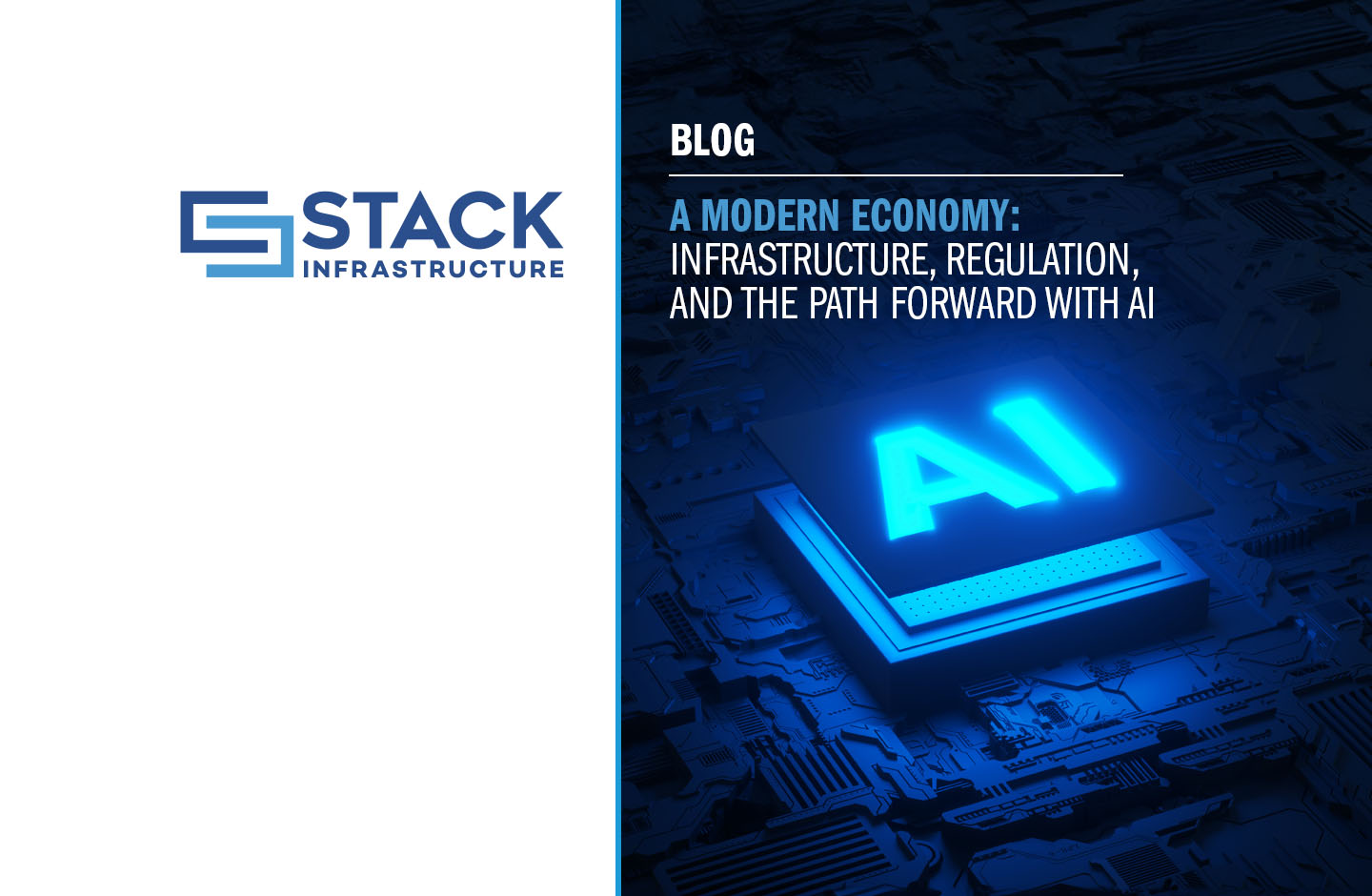A Modern Economy: Infrastructure, Regulation, and the Path Forward with AI

In the dynamic landscape of the modern economy, artificial intelligence (AI) is driving incredible leaps in innovation globally. And while today’s AI models are reshaping our world for the better, there is a global race for AI development and leadership. With the help of AI, we can increase early detection and diagnoses of diseases, optimize grid operations for energy efficiency, detect financial fraud, and analyze data faster and more accurately for scientific research.
Such innovation has the potential to significantly improve the lives of billions of people. However, realizing these exciting opportunities requires a multi-faceted strategy. The crucial need for infrastructure to support growth, along with regulatory considerations, will undoubtedly shape the future of AI and the modern economy. At the crux of this innovation transition, the data center industry has a critical role to play in the success of AI.
Developing the Infrastructure for AI: The Backbone of a Modern Economy
Jensen Huang, CEO of Nvidia, one of the pioneers in the AI hardware industry, anticipates that over $1 trillion in the next four years will be invested in current data center infrastructure to support the burgeoning AI ecosystem. Additionally, as of February 2024, Sam Altman, CEO of OpenAI, owner of ChatGPT, is seeking $7 trillion from investors to boost chip-building capacity. A comprehensive plan will be needed for financial, industrial, and governmental investment in the following areas to support this next phase of innovation:
New Data Centers: The most apparent need is the creation of new data centers. AI requires an expanded portfolio of powered land to accommodate the development of state-of-the-art data centers built to handle the high-density demands of AI workloads.
Scaling the Digital Ecosystem: Existing data center campuses and any future capacity plans must scale up computing resources, storage, and connectivity to meet the evolving AI workloads.
Evolving Data Center Design: The anticipated increase in land, power, and cooling requirements invites the onset of the next generation of data center designs that align with the exponential growth models of AI and advance efficient use of energy and water resources.
Utility Infrastructure: The energy grid must also expand at the pace and scale of AI’s growth. As discussed in a previous STACK blog post, clean energy development and investment into utilities and transmission must also take priority if we hope to fuel a sustainable, modern economy in the age of AI.
Workforce Development: To support the forthcoming growth of high-quality jobs across industries, investments into training and development programs for technology and skilled labor jobs will increase the availability of qualified personnel in key markets and help sustain a thriving economy.
AI Regulation and Data Center Infrastructure: Striking a Balance in the Digital Economy
With any groundbreaking technology comes the need to be good stewards in promoting its development and usage. This requires the technology and infrastructure pioneers to produce forward-looking strategies and protocols while enhancing both quality of life and innovation.
An important responsibility of innovators is to ensure safety across their products, from low-to-no-risk AI applications to AI applications. Most applications are low-to-no risk, and for the few that are deemed “high-risk,” innovators are working hard to ensure these systems are “safe, fair, appropriately transparent, privacy protective, and subject to appropriate oversight,” according to Nicole Foster, Director of AWS Global AI/ML and Canada Public Policy at Amazon.
Such stewardship requires collaboration with policymakers to ensure that AI is used as a tool to further protect democracy and fundamental rights. In a recent blog, Kent Walker, President of Global Affairs, Google and Alphabet, stated that what is needed is “proportionate, risk-based rules that build on existing regulations and give businesses the confidence they need to keep investing in AI innovation.”
This is not the first time the world has faced groundbreaking technology in need of responsible oversight. In 1996, amid the Dot-com boom, Section 230 of the Communications Decency Act was implemented, changing the Internet and the U.S. economy as we know it. Section 230 enabled businesses to utilize the Internet without fear of liability for removing or not removing third-party content. Digital business models flourished, and in 2021, the Internet economy contributed $3.7 trillion to the U.S. GDP total of $22.99 trillion.
The unified mission for a modern economy motivates all stakeholders, from innovators to governments to data center developers. Building upon existing technology regulations to guarantee safe use of AI enables investment into the data centers that provide a foundation for today’s digitally driven economy. It also supports job growth and tax revenue within both established and emerging data center markets.
To navigate this intricate landscape, companies and governments are proactively collaborating to voluntarily commit to Responsible AI practices. In July 2023, seven leading U.S. technology giants agreed to eight voluntary commitments as set forth by the White House, and eight more companies signed on in September.
Responsible AI practices can encompass guidelines on data privacy, transparency in AI algorithms, and the mitigation of bias. For example, The White House Commitments focus on safety (ensuring consumer products are safe before introducing them to the public), security (building systems secure from cyber threats), and trust (earning the public’s trust).
Through this collaboration, companies and governments are seeking a middle ground where innovation can flourish without compromising the well-being and privacy of individuals, safeguarding the integrity of the modern economy. This approach aims to strike a harmonious balance between innovation, competition, and investment while ensuring that AI technologies are developed and deployed ethically and responsibly.
As Microsoft CEO Satya Nadella wrote, “Perhaps the most productive debate we can have isn’t one of good versus evil: The debate should be about the values instilled in the people and institutions creating this technology.” Ensuring responsible use of technologies provides access to AI skills for people across the world, allowing the accelerated spread of ideas and strategies to advance science, medicine, sustainability, and more for global benefit.
Shaping the Future of the Modern Economy with Responsible AI
The choices we make today will set the trajectory for the future of the modern economy. Utility infrastructure development and massive investments into the increased construction and design evolution of data centers—plus a skilled workforce to support both—are central to realizing the promise of AI.
Data center developers play a crucial role in this technological revolution. STACK is already working with clients to make certain that our data centers and infrastructure meet the workload requirements of the future. STACK’s optionality and AI-ready solutions enable the world’s leading technology companies to continue to innovate with high-density racks and water-based cooling systems. Our staff are actively building relationships with policymakers and utilities to support the responsible development of AI infrastructure.
The data center industry and innovating companies must collaborate and foster communication with public affairs stakeholders, utilities, and governments to support unparalleled technological advancement. At a time when AI is shaping a new future and increasing business competition, it is essential that we work together across the industry to ensure AI shapes a strong, safe, modern economy.
Stay tuned for our next blog from STACK’s thought leaders for further insight into the evolving digital economic landscape.
By Kevin Hughes, Vice President, Public Affairs, Americas, STACK Infrastructure
May 30, 2024




